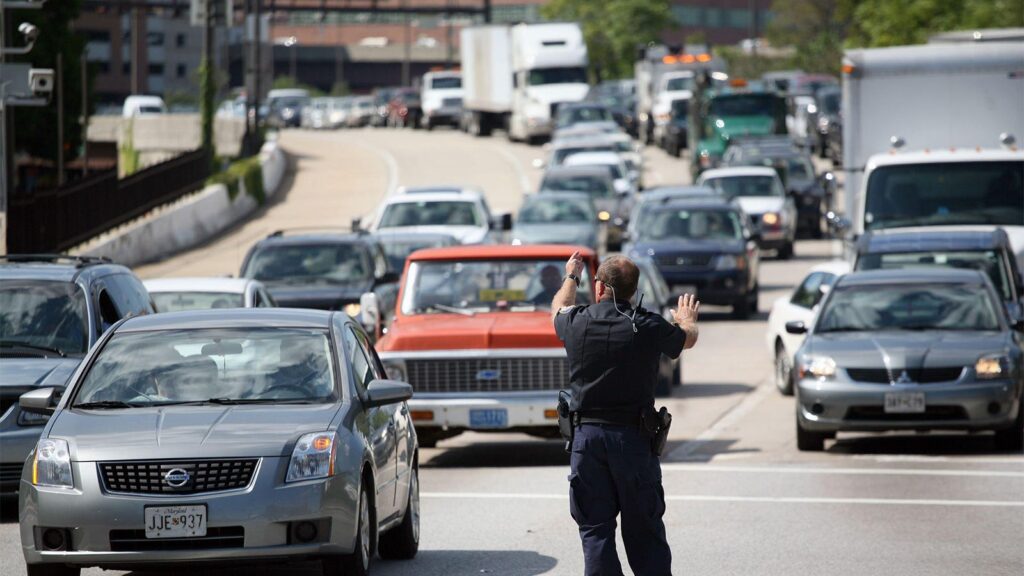Galiatsatos is a pulmonary and critical care medicine physician.
I grew up in a majority immigrant community in Baltimore with large-scale factories and several major highways surrounding us. Breathing in toxic pollution and diesel was part of living in my neighborhood. In fact, we knew the smell of pollution more than we knew the scent of fresh, clean air. Today, I am a pulmonologist, and every day, I care for adults and children who are living with chronic diseases like asthma and chronic obstructive pulmonary disease (COPD) whose health is impacted by traffic pollution.
Recently, the Environmental Protection Agency (EPA) finalized new measures to clean up vehicle emissions that will help the kids in my old neighborhood, my patients, and all of us breathe easier.
The new rules put tighter limits on greenhouse gases, particulate matter pollution, and other emissions from light-duty vehicles (like passenger cars, SUVs, and light pickups) and medium-duty vehicles (like large pickups, and package delivery vans). Separate standards also put tighter limits on greenhouse gases from heavy-duty vehicles (like trucks, transit buses, and school buses). These new rules require vehicle manufacturers to meet specified emissions limits, which vary by type of vehicle. They will go into effect for vehicles in model year 2027 and require progressively tighter limits through 2032.
These new measures are critical for cleaning up pollution from gas- and diesel-powered vehicles. Too many communities across the U.S. deal with high levels of dangerous pollution from nearby highways and trucking corridors, ports and warehouses, and other pollution hot spots. The rules will also help drive a nationwide transition to zero-emission transportation, which will have enormous benefits for public health.
Health Benefits of Cleaner Vehicles
The new rules will drive down climate change emissions over the long-term, but they will have shorter-term health benefits too.
EPA estimates that the air pollution reductions from the cleaner cars rules will provide $13 billion in annual health benefits and significantly reduce harmful pollutants by 2055. In fact, it is estimated that by 2055, the nation would see:
- 8,700 fewer tons of particulate matter
- 36,000 fewer tons of nitrogen oxides
- 150,000 fewer tons of volatile organic compounds
The reduction in fine particle pollution (PM2.5, or PM for short), is especially important. PM is associated with premature death and serious health effects such as hospital admissions due to respiratory and cardiovascular illnesses, nonfatal heart attacks, aggravated asthma, and decreased lung function. EPA estimates the new standards will prevent up to 2,500 premature deaths and avoid 400,000 asthma exacerbations by 2055.
Climate Benefits of Cleaner Vehicles
The transportation sector is not only a leading source of air pollution, it’s also one of the nation’s biggest sources of carbon pollution that drives climate change and associated public health harms.
The new rule to clean up pollution from cars may be one of the most significant rules to address climate change that EPA has ever finalized. EPA projects that it will result in 7.2 billion metric tons of reduced CO2 emissions through 2055. It is also estimated to have $72 billion in climate benefits.
The clean trucks rule will cut nearly 1 billion tons of the carbon pollution that drives climate change and slash more than 50,000 tons of nitrogen oxide pollution.
Paving the Way to a Zero-Emission Future
The rules to clean up pollution from cars and trucks are also paving the way for a nationwide transition to a zero-emission future. According to a 2022 American Lung Association report, “Zeroing in on Healthy Air,” switching to electric cars and trucks and clean electricity could save 110,000 lives and bring $1.2 trillion in public health benefits across the U.S., plus more than $1.7 trillion in climate benefits, over the next 30 years.
EPA has made significant progress in rules to improve health and address climate change this year. For example, on top of the rules to clean up vehicle emissions, the Biden administration recently announced its National Zero-Emission Freight Corridor Strategy, an initiative between several departments and agencies. The initiative will ensure there’s infrastructure in place along medium and heavy-duty freight corridors for zero-emission vehicles.
Now, there is more work to do to protect the air we breathe. EPA needs to continue its work finalizing clean air and climate protections, including measures to ratchet down toxic air emissions from burning coal and set much-needed limits on carbon pollution from power plants.
We can protect our patients with vaccines and medications to help them through respiratory symptoms; however, there is only so much we can do as healthcare providers when they are exposed to high levels of air pollution from nearby highways. These rules will make a difference in our air quality today, and on addressing climate change impacts of the future. In brief, they will help make communities healthier!
Panagis Galiatsatos, MD, MHS, is a pulmonary and critical care medicine physician, and an assistant professor at the Johns Hopkins School of Medicine where he co-directs Medicine for the Greater Good (MGG). He is also the community engagement co-director for the Baltimore Breathe Center, and a spokesperson for the American Lung Association.
Please enable JavaScript to view the

